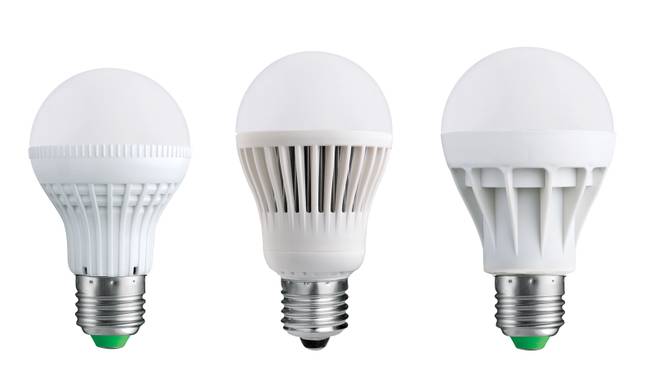
Sunday, Feb. 19, 2017 | 2 a.m.
The soft glow of that lamp by your bedside is actually waves of electromagnetic radiation. These energy waves are in the narrow band of frequencies humans can see, and based on the shade and intensity, we’re left with a distinct feeling.
That’s why there are so many bulbs on the market; the character of light changes a room and can affect your mood and focus. Walk through your home flipping the switches and ask yourself: Do I have the right light?
What determines a bulb’s brightness?
People often incorrectly assume that brightness is about wattage, but it’s not. Watts measure energy usage, while lumens indicate the intensity of the light’s output. Here’s what to look for if you’re used to buying incandescents based on wattage:
100 watts = 1,600 lumens
75 watts = 1,100 lumens
60 watts = 800 lumens
40 watts = 450 lumens
What is color temperature?
It depends on the temperature of generated light on the kelvin scale. A white light will glow with a tinge of red, yellow, white or various shades of blue the warmer it gets (so, colors we traditionally think of as “cool” are actually the hottest). “Warm white” and “soft white,” at lower kelvin, dominate in the marketplace.
Designers advise buying your lights before you paint your walls, as color changes dramatically under different color temperatures coming from bulbs. For example, candlelight is 1,900 kelvin and about 5,000 kelvin mimics daylight, so if you want to warm a room, try a bulb that’s 2,700 kelvin. If you want to cool it down, try 4,000 kelvin.
-

INCANDESCENT
Basics: While they’re not so energy-efficient, these bulbs are the most common and least expensive.
Color temperature: Warm and appealing to the psyche and complimentary to the appearance of all skin tones.
Best for: Living room and bedroom, spaces where you want to relax and unwind.
Dimmer compatible?: Yes.
Did you know?: In 2007, Congress passed legislation aimed at boosting energy efficiency and reducing greenhouse gas emissions, and it called for the phase-out of less efficient incandescents. All wattages are now required to be 25 percent more efficient, as traditional incandescent bulbs put only 10 percent of their energy toward light production, with 90 percent creating wasted energy in the form of heat.
-

HALOGEN
Basics: More efficient than incandescents, these bulbs are spendier and burn hotter.
Color temperature: The closest thing to natural daylight, sharpening the perception of color.
Best for: Kitchen and bathroom, often under cabinets or in recessed cans.
Dimmer compatible?: Yes.
Did you know?: Halogen bulbs should never be touched with bare hands, as oils transferred onto the glass can cause it to warm too fast and explode.
-

FLUORESCENT
Why are new bulb labels so useful?
They tell you how bright a bulb is and how many years it will last, the estimated annual energy cost of using it, whether it contains mercury and how warm or cool it appears.
Basics: These bulbs are the workhorses of the family, producing a lot of illumination for a long time.
Color temperature: Flat and harsh, often with a bluish tint, though there are warmer tones and colored options on the market.
Best for: Basement and garage, any large area you want to light efficiently.
Dimmer compatible?: No.
Did you know?: Extended exposure to long-tube fluorescent bulbs (found in many offices) can cause headaches due to the noticeable flicker rate.
-

COMPACT FLUORESCENT
Basics: Using about 25 percent of the energy, these bulbs perform 10 times longer than incandescents.
Color temperature: The tone is color-corrected from its long-tube ancestor, meaning it’s warmer and more inviting.
Best for: Anywhere you would use incandescents, especially offices, as the wavelength is ideal for reading.
Dimmer compatible?: Sometimes.
Did you know?: Bulbs contain trace amounts of mercury, so you should be extra-careful not to break them; recycle them when they burn out.
-

LED
Sources
HGTV, Houzz, inhabit.com, lumens.com, NASA, physicsclassroom.com, Scientific American, Tech Hive, The Verge
Basics: These bulbs last the longest on the least amount of energy, but the best option (clustered array) is five times more expensive than a compact fluorescent.
Color temperature: Warm, cool and neutral options are available, but light-emitting diodes (LEDs) can only provide directional light, meaning it bounces off the eye from just one angle rather than many (diffused).
Best for: Anywhere you need task or decorative lighting, or outdoors.
Dimmer compatible?: Yes.
Did you know?: LEDs don’t emit heat, which is why they’ve been used in novel inventions, such as a “bionic” contact lens being developed in Finland that could allow people to see content they would normally see on a computer screen right on the surface of the eye.






Join the Discussion:
Check this out for a full explanation of our conversion to the LiveFyre commenting system and instructions on how to sign up for an account.
Full comments policy